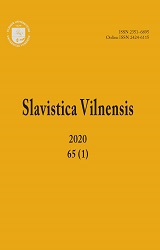Semantics of Lithuanian Baltas and Polish Biały: An Attempt at a Contrastive Analysis
Semantics of Lithuanian Baltas and Polish Biały: An Attempt at a Contrastive Analysis
Author(s): Viktorija UšinskienėSubject(s): Lexis, Semantics, Western Slavic Languages
Published by: Vilniaus Universiteto Leidykla
Keywords: color terms; semantics of color; white color; contrastive analysis;
Summary/Abstract: The paper presents the results of a contrastive semantic analysis of the Polish lexeme biały ‘white’ and its Lithuanian equivalent baltas. The research aimed at comparing the collocability of Pol. biały / Lith. baltas with names of various objects and phenomena (both in the literal and figurative senses) including the identification of the prototype references and connotative meanings. The analysis has illustrated that Pol. biały / Lith. baltas have similar ranges of use and develop almost identical connotations. In both languages, whiteness is interpreted as the lightest color whose qualitative prototype pattern is SNOW (cf.: Pol. biały jak śnieg — Lith. baltas kaip sniegas), and the quantitative prototype pattern is DAYLIGHT (cf. Pol. biały dzień — Lith. balta diena). The prototype references create characteristic connotation chains: ‘as white as snow’ — ‘pure (also morally)’ — ‘innocent’ — ‘honest’ — ‘good’; ‘as white (light) as daylight’ — ‘transparent’ — ‘obvious’ — ‘legal’ — ‘good’. The differences between the discussed units are mainly noted on the level of the lexical components with individual connotations. Apart from the few phenomena that are culturally specific (e.g. Pol. białe małżeństwo ‘a marriage without intimacy’), in the use of the lexemes biały / baltas there are no major discrepancies. Instead, it is possible to note only the asymmetry as it is in the case with the related meanings ‘clarity’ and ‘legality’ where the former has more examples in Polish, while the latter is found only in Lithuanian.
Journal: Slavistica Vilnensis
- Issue Year: 65/2020
- Issue No: 1
- Page Range: 59-71
- Page Count: 13
- Language: English

